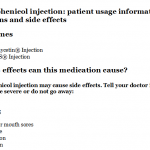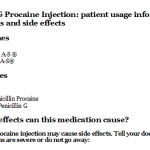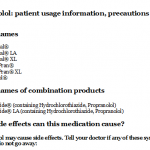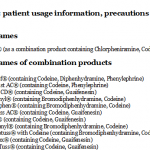
Daptacel: Diphtheria and Tetanus Toxoids and Acellular Pertussis Vaccine Adsorbed: patient information, prescribing information, ingredients, manufacturer, adverse reactions and side effects
Friday, April 07, 2017 by Gregory Van Dyke
http://www.naturalnewsreference.com/2017-04-07-daptacel-diphtheria-and-tetanus-toxoids-and-acellular-pertussis-vaccine-adsorbed-patient-information-prescribing-information-ingredients-manufacturer-adverse-reactions-and-side-effects-2.html
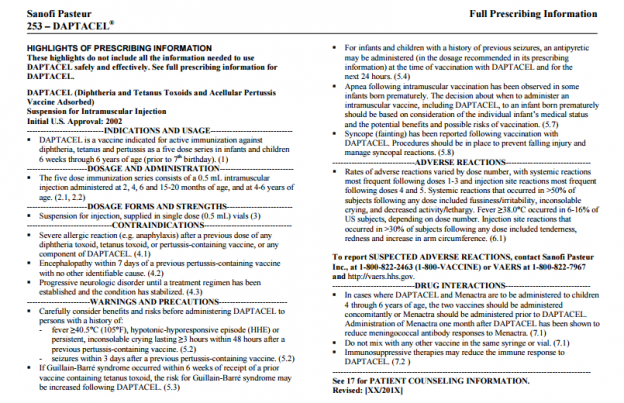
HIGHLIGHTS OF PRESCRIBING INFORMATION
These highlights do not include all the information needed to use Pentacel safely and effectively. See full prescribing information for Pentacel.
See full insert sheet at this link at the Natural News Reference website.
Pentacel (Diphtheria and Tetanus Toxoids and Acellular Pertussis Adsorbed, Inactivated Poliovirus and Haemophilus b Conjugate (Tetanus Toxoid Conjugate) Vaccine
Suspension for Intramuscular Injection
Initial U.S. Approval: 2008
INGREDIENTS AND EXCIPIENTS
Pentacel consists of a Diphtheria and Tetanus Toxoids and Acellular Pertussis Adsorbed and Inactivated Poliovirus (DTaP-IPV) component and an ActHIB® 276 component combined through reconstitution for intramuscular injection. ActHIB (Haemophilus b Conjugate Vaccine [Tetanus Toxoid Conjugate]), consists of H. influenzae type b capsular polysaccharide (polyribosyl-ribitol- phosphate [PRP]) covalently bound to tetanus toxoid (PRP-T). The DTaP-IPV component is supplied as a sterile liquid used to reconstitute the lyophilized ActHIB component to form Pentacel. Pentacel is a uniform, cloudy, white to off-white (yellow tinge) suspension.
Each 0.5 mL dose contains 15 Lf diphtheria toxoid, 5 Lf tetanus toxoid, acellular pertussis antigens [20 mcg detoxified pertussis toxin (PT), 20 mcg filamentous hemagglutinin (FHA), 3 mcg pertactin (PRN), 5 mcg fimbriae types 2 and 3 (FIM)], inactivated polioviruses [40 D-antigen units (DU) Type 1 (Mahoney), 8 DU Type 2 (MEF-1), 32 DU Type 3 (Saukett)] and 10 mcg PRP of H. influenzae type b covalently bound to 24 mcg of tetanus toxoid (PRP-T). Other ingredients per 0.5 mL dose include 1.5 mg aluminum phosphate (0.33 mg aluminum) as the adjuvant, polysorbate 80 (approximately 10 ppm by calculation), 42.5 mg sucrose, ≤5 mcg residual formaldehyde, <50 ng residual glutaraldehyde, ≤50 ng residual bovine serum albumin, 3.3 mg (0.6% v/v) 2-phenoxyethanol (not as a preservative), <4 pg of neomycin and <4 pg polymyxin B sulfate.
Corynebacterium diphtheriae is grown in modified Mueller’s growth medium. (6) After purification by ammonium sulfate fractionation, the diphtheria toxin is detoxified with formaldehyde and diafiltered.
Clostridium tetani is grown in modified Mueller-Miller casamino acid medium without beef heart infusion. (7) Tetanus toxin is detoxified with formaldehyde and purified by ammonium sulfate fractionation and diafiltration. Diphtheria and tetanus toxoids are individually adsorbed onto aluminum phosphate.
The acellular pertussis vaccine antigens are produced from Bordetella pertussis cultures grown in Stainer-Scholte medium (8) modified by the addition of casamino acids and dimethyl-beta- cyclodextrin. PT, FHA and PRN are isolated separately from the supernatant culture medium. FIM are extracted and copurified from the bacterial cells. The pertussis antigens are purified by sequential filtration, salt-precipitation, ultrafiltration and chromatography. PT is detoxified with glutaraldehyde. FHA is treated with formaldehyde and the residual aldehydes are removed by ultrafiltration. The individual antigens are adsorbed separately onto aluminum phosphate
Poliovirus Type 1, Type 2 and Type 3 are each grown in separate cultures of MRC-5 cells, a line of normal human diploid cells, by the microcarrier method. (9) (10) The cells are grown in CMRL (Connaught Medical Research Laboratories) 1969 medium, supplemented with calf serum. For viral growth, the culture medium is replaced by Medium 199, without calf serum. After clarification and filtration, the viral suspensions are concentrated by ultrafiltration, and purified by liquid chromatography steps. The monovalent viral suspensions are inactivated with formaldehyde. Monovalent concentrates of each inactivated poliovirus are combined to produce a trivalent poliovirus concentrate.
The adsorbed diphtheria, tetanus and acellular pertussis antigens are combined with aluminum phosphate (as adjuvant), 2-phenoxyethanol (not as a preservative) and water for injection, into an intermediate concentrate. The trivalent poliovirus concentrate is added and the DTaP-IPV component is diluted to its final concentration. The DTaP-IPV component does not contain a preservative.
Both diphtheria and tetanus toxoids induce at least 2 neutralizing units per mL in the guinea pig 320 potency test. The potency of the acellular pertussis antigens is evaluated by the antibody response 321 of immunized mice to detoxified PT, FHA, PRN and FIM as measured by enzyme-linked 322 immunosorbent assay (ELISA). The potency of inactivated poliovirus antigens is determined by 323 measuring antibody-mediated neutralization of poliovirus in sera from immunized rats.
PRP, a high molecular weight polymer, is prepared from the Haemophilus influenzae type b strain 325 1482 grown in a semi-synthetic medium. (11) The tetanus toxoid for conjugation to PRP is 326 prepared by ammonium sulfate purification, and formalin inactivation of the toxin from cultures 327 of Clostridium tetani (Harvard strain) grown in a modified Mueller and Miller medium. (12) The 328 toxoid is filter sterilized prior to the conjugation process. The ActHIB component does not 329 contain a preservative. Potency of the ActHIB component is specified on each lot by limits on the 330 content of PRP polysaccharide and protein per dose and the proportion of polysaccharide and 331 protein that is characterized as high molecular weight conjugate.
The vial stoppers for the DTaP-IPV and ActHIB components of Pentacel are not made with 333 natural rubber latex.
INDICATIONS AND USAGE
Pentacel is a vaccine indicated for active immunization against diphtheria, tetanus, pertussis, poliomyelitis and invasive disease due to Haemophilus influenzae type b. Pentacel is approved for use as a four dose series in children 6 weeks through 4 years of age (prior to 5th birthday). (1)
DOSAGE AND ADMINISTRATION
The four dose immunization series consists of a 0.5-mL intramuscular injection, after reconstitution, administered at 2, 4, 6 and 15-18 months of age. (2.1)
Pentacel consists of a liquid vaccine component (DTaP-IPV component) and a lyophilized vaccine component (ActHIB vaccine). Reconstitute the ActHIB vaccine component with the DTaP-IPV component immediately before administration.(2.2)
DOSAGE FORMS AND STRENGTHS
Suspension for injection (0.5-mL dose) supplied as a liquid vaccine component that is combined through reconstitution with a lyophilized vaccine component, both in single dose vials. (3)
CONTRAINDICATIONS
Severe allergic reaction (eg, anaphylaxis) after a previous dose of Pentacel, any ingredient of Pentacel, or any other diphtheria toxoid, tetanus toxoid, pertussis-containing vaccine, inactivated poliovirus vaccine or H. influenzae type b vaccine. (4.1)
Encephalopathy within 7 days of a previous pertussis-containing vaccine with no other identifiable cause. (4.2)
Progressive neurologic disorder until a treatment regimen has been established and the condition has stabilized. (4.3)
WARNINGS AND PRECAUTIONS
Carefully consider benefits and risks before administering Pentacel to persons with a history of:
– fever ≥40.5°C (≥105°F), hypotonic-hyporesponsive episode (HHE) or persistent, inconsolable crying lasting ≥3 hours within 48 hours after a previous pertussis-containing vaccine. (5.2)
– seizures within 3 days after a previous pertussis-containing vaccine. (5.2)
ADVERSE REACTIONS
Rates of adverse reactions varied by dose number. Systemic reactions that occurred in >50% of participants following any dose included fussiness/irritability and inconsolable crying. Fever ≥38.0°C occurred in 6- 16% of participants, depending on dose number. Injection site reactions that occurred in >30% of participants following any dose included tenderness and increase in arm circumference. (6.1)
To report SUSPECTED ADVERSE REACTIONS, contact Sanofi Pasteur Inc., at 1-800-822-2463 (1-800-VACCINE) or VAERS at 1-800-822-7967 and http://vaers.hhs.gov.
DRUG INTERACTIONS
Do not mix Pentacel or any of its components with any other vaccine or diluent. (7.1)
Immunosuppressive therapies may reduce the immune response to Pentacel. (7.2 )
Urine antigen detection may not have definitive diagnostic value in suspected H. influenzae type b disease within one week following Pentacel. (7.3)
USE IN SPECIFIC POPULATIONS
Pregnancy
Pregnancy Category C: Animal reproduction studies have not been conducted with Pentacel. It is also not known whether Pentacel can cause fetal harm when administered to a pregnant woman or can affect reproductive capacity.
Pediatric Use
The safety and effectiveness of Pentacel was established in the age group 6 weeks through 18 270 months on the basis of clinical studies. [See Adverse Reactions (6.1) and Clinical Studies (14).] 271 The safety and effectiveness of Pentacel in the age group 19 months through 4 years is supported 272 by evidence in children 6 weeks through 18 months. The safety and effectiveness of Pentacel in 273 infants less than 6 weeks of age and in children 5 to 16 years of age have not been established.
Revised: [09/2016]
https://www.fda.gov/downloads/BiologicsBloodVaccines/Vaccines/ApprovedProducts/UCM109810.pdf
Tagged Under: Tags: daptacel, dosage, ingredients, insert sheet, side effects, usage, warnings

